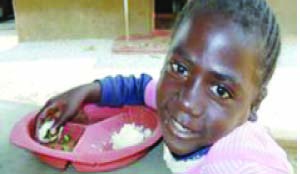
• POOR nutrition is still observed as a serious social and economic problem in some rural households in Zambia.
By Natasha Mhango –
THE North-Western Province of Zambia is mostly associated with its mining activities. It is seldom remembered that agriculture is also a key economic activity among most its people.
On the agricultural front, the Province is composed of plains and plateaus which consist of sandy, sandy loamy and loamy soils in various areas.
In Zambezi District in particular, acting district crops husbandry officer for the Ministry of Agriculture, Lofters Man’gola, explains that there are high levels of soil leaching in most parts of the area.
“The District receives rainfall which ranges from 1000-1200mm and so we encourage farmers to plant on time before heavy rainfall begins most especially considering the high levels of soil leaching,” Mr Man’gola said.
Considering these conditions, early planting is a viable option to enhancing sustainable agriculture in such an area. Early planting entails early tillage; and early tillage is somewhat synonymous to conservation agriculture. It is no wonder that the Conservation Agriculture Scaling Up (CASU) project which is being funded by the European Union (EU) and implemented by the Food and Agriculture Organisation (FAO), has included Zambezi District among their targets in scaling up the adoption of Conservation Agriculture.
While conservation agriculture enhances better yields and conservation of the environment, the aspect of inter-cropping and crop rotation is proving to be an effective way to also enhance better nutrition levels among small scale farmers.
According to “The State of Food Insecurity in the World “ 2014 report compiled by the FAO, the International Fund for Agricultural Development(IFAD) and World Food Program(WFP), “, about 805 million people are estimated to be chronically undernourished in 2012–14…,” (pg.1)
Nonetheless, poor nutrition is still observed as a serious social and economic problem in some rural households in Zambia. Furthermore, it is children who are most affected by this scourge.
Crop diversification through crop rotation and inter-cropping is proving to be a viable solution towards the problem of nutrition while also enhancing the economic base of rural households.
Evaristo Kalukangu is a small-scale lead farmer in Mpidi agricultural camp located in Zambezi district.
Through extension staff under the Ministry of Agriculture and Livestock, CASU has trained farmers like Mr Kalukangu on the principles of conservation agriculture such as early tillage and crop rotation, among others.
“I have been practising conservation farming for a year and a half. I have been practising crop rotation. I have been planting groundnuts, cow peas and pigeon peas. I also grow beans for consumption and for cash,” Mr. Kalukangu explained. He, however, highlighted his desire for more training on how to improve nutrition in his household.
“We as lead farmers need more training in improving nutrition so that we can in turn teach our follower farmers on how to prepare better meals,” Mr Kalukangu added.
Luka Chineya is another lead farmer based at Kanyilaba agricultural camp. Being a lead farmer, he is among the 21,000 lead farmers that CASU is working with countrywide.
“Depending on the number of people who are at home at a given time, we can eat sweet potatoes or cassava. We also eat some groundnuts and beans sometimes,” Mr Chineya said.
According to him, his fellow farmers have been eating three meals a day since they adopted conservation farming techniques. However, not all these three meals are nutritionally balanced all the time.
Mr Chineya agrees that though farmers are diversifying their crop production, there seems to be more that they need to learn on how to balance their meals and make them more nutritious.
Kennedy Mwamba is the acting-nutrition officer for the Ministry of Agriculture and Livestock in Zambezi district. He explained that the staple food that is grown in the area includes cassava and maize. These are used to prepare nshima and are usually eaten with vegetables like cassava leaves; which are occasionally cooked in powdered groundnuts. In some cases, they eat their nshima with kakeya –a small type of fish that is mostly found in the Zambezi River.
Mr Mwamba is however, noted that though farmers are diversifying their crop production, there are still poor nutrition levels at household level.
“The problem is that farmers lack sufficient knowledge on how to process and preserve foods to enable storage for a longer period of time. Furthermore, there is still need to learn how to combine foods to make a balanced meal,” Mr. Mwamba said.
Through farmer field schools that are conducted under the CASU project, it is equally important that issues of nutrition are addressed as principles of Conservation Agriculture are being taught. Lead farmers are being taught on nutrition, the main food ground and their functions in the human body; and they are expected to share this information with their follower farmers.
Furthermore, in addition to these trainings, Mr Mwamba disclosed that farmers are now being encouraged to grow fortified orange maize, fortified sweet potatoes – both fortified with vitamin A. Other crops include iron-rich beans as well as soya beans. These are provided to farmers by the department itself.
He adds that the lack of proper preservation is a significant reason for poor nutrition levels in some farmer households.
In addition, there is a relationship between gender and nutrition which can never be over-emphasised. Women are renowned to be natural care-givers beginning from the time they breast-feed their children and; including the traditionally expected role of household culinary chores.
Inclusion of more women in agriculture therefore goes without saying that nutrition levels are bound to improve at household levels. CASU is striving to achieve a minimum of 40per cent of women farmers in the project.
Considering the need to scale up conservation agriculture through increased participation of women, it can be concluded that such an effort will in turn, enhance nutrition levels in the district.-NAIS






